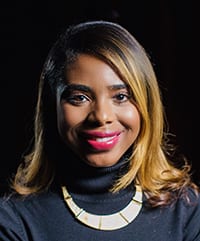
[Editor’s Note: As part of our series of interviews with senior PR pros in new positions, we spoke recently with Emily Graham, who was named FleishmanHillard’s first chief diversity and inclusion officer June 17, 2020. Graham’s appointment was the first major action resulting from a diversity, equity and inclusion (DEI) plan that CEO/president John Saunders announced two days prior.
Graham will report to Saunders and J.J. Carter, COO. She’ll work alongside a global DEI task force to “analyze recruitment, retention, compensation, training and development opportunities for colleagues,” according to a FleishmanHillard announcement. She also will lead True Mosaic, a global community of multicultural counselors at the firm who will offer DEI input to clients, the company and the industry.
Graham has served on FleishmanHillard’s leadership cabinet for two years and co-led the financial and professional services sector group for the Americas. PRNEWS honored her as a Top Woman in PR this year and Crain’s NY Business named her a 40 Under 40 honoree. Before joining FleishmanHillard in 2017, Graham held senior positions at MWWPR and Burson-Marsteller. Her edited remarks are below.]
PRNEWS: Normally we’d ask about your priorities in this new position. Reading John Saunders’s memo, they seem clear. So, we’ll begin by discussing the values, assumptions and principles you’ll rely on as you seek to improve DE&I at FleishmanHillard. PR is said to be about 80+ percent white. Why is that, and what can be done about it?

Chief Diversity & Inclusion Officer
FleishmanHillard
Emily Graham: I’ve been part of the industry nearly 15 years, and in that time I’ve not seen any indicators that we’ve made significant progress with ethnic diversity.
As communicators and strategists, we can define and refine a plan beautifully, but for change to happen, conviction and passion must translate into action. We can learn and get guidance on what that action looks like, but commitment and passion must be personal, inherent and without compromise.
I believe there was a time when it was acceptable to have one or two people of color as signs of progress or tokens. It’s untenable and unacceptable in 2020.
What’s needed now is not performative; it’s substantive.
When you look at the founder of Reddit stepping down from the board and saying, ‘Replace me with a Black person,’ that is immediate action and undeniable change. How many leaders of PR firms would do that upon their departure or in advance of it? That’s one place we could start.
If every agency–big, mid-size and small–looks at its succession plan for leadership and ensures there is at least one person of color on track to make it into the C-suite or second tier of leadership in the next year, that is impact that makes a difference.
It’s really important that we think as much about what we’re going to do in the next 12 months as we do about the next three, five or 10 years.
Urgency, insatiable drive to do better and immediate, specific actions that benefit Black and Brown talent are how we will make change. Until then, we are going to have more words that sound great and calls to action and pledges that go unanswered.
PRNEWS: John Saunders’s memo discusses “changing our agency’s face.” FH’s leadership is famously gender-diverse. But, correct me if I’m wrong, it’s not as racially diverse.
Graham: I’m an example of ethnically diverse leadership at FleishmanHillard...I’ve worked very hard in my career to attain leadership and others have too, even though our numbers across the industry are limited, so we can’t and shouldn’t discount that.
But I know I am not satisfied, nor is our agency leadership, with limited diverse representation. We cannot, and should not, look at our composition and be satisfied.
PRNEWS: So, what are some of the first steps you’ve taken to change FH’s face on the leadership level and in the senior ranks? Considering, as we noted, the industry is 80+ percent white, how long will it take you and FH to do this?
Graham: The first thing I did was sit with our agency leadership and acknowledge the uncomfortable truth–because if we don’t know what we are facing, we can’t effectively address it together. Racism and bias are human rights issues–it is personal, and we are people first.
I’ve connected with each of our leaders and I’ve heard their [personal] commitments and their commitments to FleishmanHillard, and so I know these issues matter to them beyond our walls. What use is it for leadership to commit to changing the agency, but not commit to changing our society?
It’s also important to note this can’t be a numbers exercise; this is also about culture and belonging. The reason Black talent and people of color don’t thrive in communications is not about recruiting–it’s about a biased workplace, lack of mentorship, poor career pathing, limited growth opportunities and more.
PRNEWS: How do you attack those challenges?
Graham: Immediately, I’ve set out to address those issues– and just like racism, there’s not one reason they exist, but there are multiple ways we must attack it.
We are listening to each and every Black and diverse employee to understand their needs, their ambitions, where we have fallen short and how we can be an agency they are proud of [working at]. That, along with our previously shared commitments, is already in action.
Perfection is the enemy of progress. We are working to make changes quickly that will be measured, scaled and benchmarked.
We want to see real progress in composition by year’s end, but where we are a year from now matters critically to me too. Sustainability and continuity are both required–one speaks to depth and longevity, and the other to cadence.
PRNEWS: Continuing from the previous question, and understanding it’s not totally a question of numbers, what does FH’s rank-and-file staff look like in terms of diversity? How will it change? And how long will that take?
Graham: We have 22 percent ethnic diversity represented on our Cabinet–our executive leadership team–and more than 60 percent of our offices are women-led. In terms of additional composition, we are unable to share given guidance from our parent company, but we are committed to more diversity at every level, in every region. DE&I is center to all we do, and all we talk about, and we won’t be satisfied until we see a new FleishmanHillard reflecting the world we live in.
PRNEWS: Saunders’s memo also says FH will create a benchmark by July 15 “for our DE&I progress.” Can you tell us what that will look like? Will your DE&I numbers be available to the public?
Graham: We had an ambition for DE&I that was created in late 2017 for 2020. Now 2020 is here and it’s time to recast our ambition. It will be intentional, measured, aggressive and we will hold ourselves accountable. We’ve shared our initial commitments publicly, and we plan to share an update mid-July with additional commitments and actions to date.
PRNEWS: Great. What advice would you offer on DE&I to PR shops that lack the resources of FH?
Graham: No one can deny that funding is essential. But I challenge the industry to look inward, at what doesn’t require money. Often what doesn’t require money hinders DE&I.
I’d ask, are you treating DE&I as a strategic business imperative, critical to your bottom line and operations? Are you combatting and confronting bias and racism on purpose, in real-time in your companies? Do you know, and have you challenged, leadership’s role in progress–are they all-in, or are they performative allies? Have you made DE&I progress part of their performance review and compensation strategy? And have you made it imperative in client engagements that DE&I is included, not as a multicultural month, but as a driving factor for reputation and stakeholder engagement?
Have you done the work to enable honest, uncomfortable, intentional discussions about the above? That is where we must be willing to go so we can be sure that our collective will is strong enough to drive the change we need.
We must recognize that with intention, accountability and purpose, we can achieve a lot. Don’t let processes, critiques and consensus paralyze you. Instead, begin moving, refining and learning as we move together.
CONTACT: [email protected]
